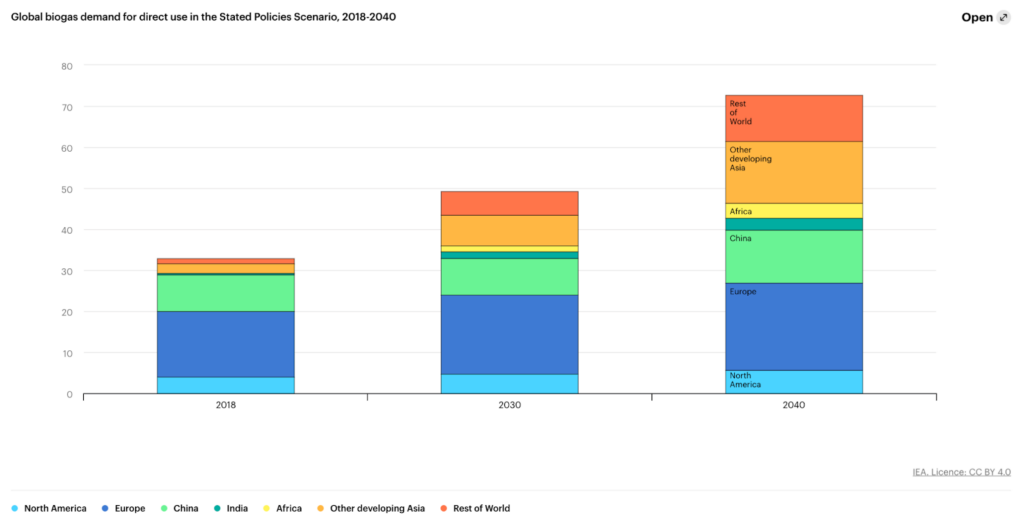The History of Biogas: The Big Picture
Impactful Ninja is reader-supported. When you buy through links on our site, we may earn an affiliate commission.
Learn more
Learn more
.
Hey fellow impactful ninja ? You may have noticed that Impactful Ninja is all about providing helpful information to make a positive impact on the world and society. And that we love to link back to where we found all the information for each of our posts. Most of these links are informational-based for you to check out their primary sources with one click. But some of these links are so-called "affiliate links" to products that we recommend. First and foremost, because we believe that they add value to you. For example, when we wrote a post about the environmental impact of long showers, we came across an EPA recommendation to use WaterSense showerheads. So we linked to where you can find them. Or, for many of our posts, we also link to our favorite books on that topic so that you can get a much more holistic overview than one single blog post could provide. And when there is an affiliate program for these products, we sign up for it. For example, as Amazon Associates, we earn from qualifying purchases. First, and most importantly, we still only recommend products that we believe add value for you. When you buy something through one of our affiliate links, we may earn a small commission - but at no additional costs to you. And when you buy something through a link that is not an affiliate link, we won’t receive any commission but we’ll still be happy to have helped you. When we find products that we believe add value to you and the seller has an affiliate program, we sign up for it. When you buy something through one of our affiliate links, we may earn a small commission (at no extra costs to you). And at this point in time, all money is reinvested in sharing the most helpful content with you. This includes all operating costs for running this site and the content creation itself. You may have noticed by the way Impactful Ninja is operated that money is not the driving factor behind it. It is a passion project of mine and I love to share helpful information with you to make a positive impact on the world and society. However, it's a project in that I invest a lot of time and also quite some money. Eventually, my dream is to one day turn this passion project into my full-time job and provide even more helpful information. But that's still a long time to go. Stay impactful,Affiliate Disclosure
Why do we add these product links?
What do these affiliate links mean for you?
What do these affiliate links mean for us?
What does this mean for me personally?
![]()
Biogas is a combustible gas derived from biomass sources which some believe to be a more sustainable alternative to natural gas. Turning our waste into energy, instead of letting the gasses they emit enter our atmosphere, can help mitigate climate change. So, we had to ask: What is the history of biogas?
Biogas energy began in 900 BC when biogas was used to heat water. Biogas production was then advanced with the invention of the anaerobic digestion tank in 1906 and the recognition of microbiology as a scientific discipline in the 1930s. Since 2000, biogas has been part of mainstream energy.
Keep reading to learn how biogas came to be, who and what pioneered its development, how effective it has been thus far, and what the future of biogas could entail.
Here’s the History of Biogas in a Nutshell
Biogas is an energy-rich form of biomass, a renewable organic material that comes from plants and animals.
Biogas is a gaseous mixture of 45% to 75% methane (CH4), carbon dioxide (CO2), and small quantities of other gasses created through anaerobic digestion or thermochemical conversion of biomass in an oxygen-free environment.
“Biogas: a gas containing methane that can be burned as a fuel, produced by dead plants and animals as they decay”
Cambridge Dictionary
Biogas is either burned to create electricity or can be further purified down into renewable natural gas (i.e., biomethane) which can be used in place of conventional natural gas (NG).
Capturing the gasses naturally produced via the decay of organic matter and using them as an energy source, rather than allowing them to escape into the atmosphere, makes biogas a beneficial energy source.
Biogas has gone through three distinct development phases in its development:
- Early market formation and innovation: The early history of biogas energy dates back to 900 BC when the Assyrians used biogas to heat their bathwater. The discovery that flammable gasses could be produced from decaying, organic matter in the 1600s helped shape our knowledge of the anaerobic digestion process as it is today.
- Consolidation and strengthening: The early 1900s saw the development of anaerobic digestion tanks, which replaced anaerobic lagoons. Anaerobic digestion tanks are essential for the controlled biological process that converts organic waste into biogas. Research into anaerobic digestion soared in the 1930s following the establishment of microbiology as a recognized scientific discipline.
- Mainstreaming: Petroleum shortages during the First and Second World Wars and the Energy Crisis in the 1970s sparked interest in anaerobic digestion and spurred technological advances. Beginning in 2000, biogas began to establish itself as a major player in the renewable energy industry. The establishment of The International Energy Agency, World Bioenergy Association, World Biogas Association, and Global Methane Pledge have helped to shape the modern biogas industry.
| Biogas Milestones | Historical Event |
| Initial start | The early history of biogas energy dates back to 900 BC when the Assyrians used biogas to heat their bathwater. The discovery that flammable gasses could be produced from decaying, organic matter in the 1600s helped shape our knowledge of the anaerobic digestion process as it is today. |
| Milestones in biogas development | 1808: Sir Humphrey Davy established that cow manure produced methane. Manure would become a prominent feedstock for biogas today. 1859: The first anaerobic digestion plant—essential to convert organic waste into biogas—was constructed in a leper colony in Bombay (presently Mumbai), India. 1895: Biogas was recovered from the sewage system in Exeter (United Kingdom) and used to light street lamps. 1906: Karl Imhoff invented the Imhoff Tank, a two-chambered tank to receive and process sewage. His design would become an early form of anaerobic digestion (biogas) plants in operation today. 1914-1918: Interest in biogas decreased when petroleum became the dominant fuel in World War I. 1930s: Microbiology became a recognized scientific discipline, which led to a massive amount of research taking place on anaerobic digestion, bacteria, and methane. 1939-1945: Biogas interest increased due to widespread petroleum shortages during World War II. When the war ended, interest in biogas again decreased as petroleum availability returned to normal levels. 1950s: Activated sludge systems became established as a way to apply anaerobic digestion to solid waste. 1970s: The Energy Crisis of 1970, caused by disruptions to the supply chain via wars in the Middle East, renewed interest in anaerobic digestion. 1970s: China adopted anaerobic digestion technology on a massive scale in the form of small household digesters. 1991: Germany became the first country in the world to implement feed-in tariffs (FIT) to support the expansion of anaerobic digestion technology. 2000: Biogas production increased noticeably more than fivefold from 0.29 exajoules in 2000 to 1.46 exajoules in 2022. |
| Current status | Currently, Europe, China, and the US account for 90% of global biogas production. We produce over 38 billion cubic meters (bcm) of biogas annually. Of the 685 Terawatt hours (TWh) of electricity that were produced globally from biomass sources in 2020, biogas accounted for 13% (89 TWh) of total biopower production. |
| Future outlook | The future of biogas will be heavily influenced by ambitious government targets, policy support, increasing competitiveness of biogas energy companies, and decreasing the upfront costs associated with installing biogas technologies. |
| Key policy developments | 1974 – The International Energy Agency (IEA) 2008 – World Bioenergy Association 2009 – European Biogas Association (EBA) 2009 – The International Renewable Energy Agency (IRENA) 2010 – American Biogas Council (ABC) 2011 – African BioRenewable Association (ABA) 2014 – Asia Pacific Biogas Alliance (APBA) 2015 – The Paris Climate Agreement 2016 – World Biogas Association 2021 – Global Methane Pledge |
Understanding biogas energy’s history can provide insight into how it has evolved into the energy source it is today.
When and How Did Biogas Get Started
Humans have known about and harnessed biogas energy for centuries, dating back to 900 BC when the Assyrians used biogas to heat their bathwater.
In the 1600s, Jan Baptist van Helmont discovered that flammable gasses could be produced from decaying, organic matter. He also coined the word “gas” at that time.
Then, Count Alessandro Volta discovered methane emissions from naturally occurring aerobic sites (soils and oceanic basins) in 1776. His discovery would form the basis of how we view anaerobic digestion today.
How Has Biogas Developed Over Time
Biogas can play an important role in the global energy transformation and help transition away from fossil fuels because it puts to use some of the billions of tons of waste that would otherwise emit greenhouse gasses into our atmosphere.
What Are Milestones in Biogas Development
The invention of the world’s first anaerobic digestion tank system kickstarted the modern biogas industry, which has today grown into a nearly $60 billion industry.
1808: Sir Humphrey Davy established that cow manure produced methane. Manure would become a prominent feedstock for biogas today.
1859: The first anaerobic digestion plant—essential to convert organic waste into biogas—was constructed in a leper colony in Bombay (presently Mumbai), India. Little is known about the plant except it was built to manage sewage in the colony.
1895: Biogas was recovered from the sewage system in Exeter (United Kingdom) and used to light street lamps.
1906: German engineer Karl Imhoff invented the Imhoff Tank, a two-chambered tank to receive and process sewage. His design would become an early form of anaerobic digestion (biogas) plants in operation today. It also signaled a switch from anaerobic lagoons to anaerobic tank systems.
1914-1918: Petroleum became the dominant fuel in World War I, leading to a decreasing interest in biogas as energy.
1930s: Microbiology became a recognized scientific discipline, which led to a massive amount of research taking place on anaerobic digestion, bacteria, and methane.
1939-1945: Petroleum shortages during World War II caused interest in biogas to surge, with the Germans using fueling machinery and vehicles with sewage and biogas. When the war ended, interest in biogas again decreased as petroleum availability returned to normal levels.
1950s: Activated sludge systems became established as a way to apply anaerobic digestion to solid waste.
1970s: The Energy Crisis of 1970, caused by disruptions to the supply chain via wars in the Middle East, renewed interest in anaerobic digestion.
1970s: China adopted anaerobic digestion technology on a massive scale in the form of small household digesters.
1991: Germany became the first country in the world to implement feed-in tariffs (FIT) to support the expansion of anaerobic digestion technology. The number of anaerobic digestion plants grew from 20 to over 500 between 1991 to 1998.
2000: Biogas production began to increase noticeably beginning in 2000, with global production increasing more than fivefold from 0.29 to 1.46 exajoules between 2000 and 2022.
The 21st century has seen a focus on developing biogas technologies and expanding biogas to more rural areas (e.g., clean cooking technologies in African communities).
How Has the Biogas Market Developed Recently
The recent growth of the biogas industry can be attributed to the development of alternative waste treatment methods (instead of dumping it in landfills) coupled with the need to switch from fossil fuel-based energy sources (e.g., coal, oil, natural gas) to renewable energy sources.
Global biogas production has increased from over 7 billion cubic meters in 2000 to over 38 billion cubic meters in 2020. Europe, China, and the United States are the well-established world leaders in biogas, with some African countries more recently scaling up their biogas industries.
What Is the Present Status of Biogas
In 2020, 38.1 billion cubic meters (bcm) of biogas were produced globally. And of the 685 Terawatt hours (TWh) of electricity that were produced globally from biomass sources, biogas accounted for 13% (89 TWh) of total biopower production.
We currently have over 50 million micro-biodigesters, 132,000 small/medium/large scale biodigesters, and 700 upgrading plants (to produce biomethane) in operation worldwide. However, there has been an uneven distribution of biogas technologies due to the disproportionate availability of materials, funding, and policies among countries. Altogether, Europe, China, and the US account for 90% of global biogas production.
Europe is the leading biogas-producing region. They produced over 30 billion cubic meters of biogas in 2019, accounting for more than 50% of the global biogas supply. There are over 20,000 biogas plants operating in Europe, more than half of which are in Germany. Denmark, France, Italy, and the Netherlands are other European countries currently pushing for biogas.
China’s biogas industry has evolved from household-scale digesters in rural areas to large-scale biogas plants. Today, China has over 39 million household digesters and over 100,000 biogas plants. They produced over 11 billion cubic meters of biogas in 2018, most of which were used for residential gas and power generation.
The US mainly uses landfill methane and some animal waste as sources of biogas, which account for 90% of their biogas production. There are roughly 2,400 operational biogas plants in all 50 states. Experts estimate there could be an additional 15,000 sites that are suitable for biogas production, which could produce 103 trillion kilowatt hours of electricity a year.
How Will the Future of Biogas Look Like
Scaling up biomass will require ambitious government targets, policy support, increasing competitiveness of biogas energy companies, and decreasing the upfront costs associated with installing biogas technologies.
How Biogas Will Likely Develop in the Future
We can potentially generate between 10,000 and 14,000 terawatt-hours (TWh) of biogas energy from biomass feedstocks, the equivalent of meeting 6-9% of the world’s energy consumption, 23-32% of the world’s coal consumption, and 16-22% of the world’s electricity consumption.
Because the potential is so great, the biogas industry is forecasted to grow at a 5% compound annual growth rate between 2020 and 2030, and estimates suggest that its market value will increase from $58 billion in 2022 to $89 billion by 2030.
The International Energy Agency (IEA) has developed the Stated Policies Scenario (STEPS) to forecast the future of biogas energy through 2040. The STEPS takes into account where the industry is now based on already announced climate policies and available market technology data.
According to the STEPS, the market share of biogas and biomethane combined will increase from 5% today to 12% by 2040. Developing countries in Asia are predicted to lead direct biogas demand, and the share of biogas used for power and heat will increase from 70% today to 85% by 2040.

There is also a push for biogas to replace conventional cooking methods such as fuelwood, charcoal, coal, kerosene, and dung burned in open fires. Air pollution stemming from inefficient cooking methods was linked to 500,000 premature deaths in Sub-Saharan Africa in 2018. Household air pollution, mostly from cooking smoke, is linked to 3.7 million premature deaths globally.
There are roughly 2.3 billion people worldwide living without access to clean cooking facilities, 900 million of whom are located in Sub-Saharan Africa alone. Experts predict that by 2030, 200 million people (half of whom are in Africa) will move away from traditional biomass and towards technologies including household biodigesters, which convert organic waste into biogas. These digesters reduce air pollution and support development in rural communities.
The high upfront cost associated with installing household biodigesters is the main economic barrier preventing their widespread installation today. Despite paying for themselves in as little as 2 years, they can cost between $500-$800 upfront, which is significant in rural African communities. In order to compete with other clean cooking technologies (e.g., kerosene/natural gas/electric stoves) the costs will have to decrease.
What Policies Are Put in Place to Support Biogas Usage
The most well-known piece of legally binding, international climate mitigation legislation is The Paris Agreement, the goal of which is to limit global warming to below 2 degrees Celsius (C), preferably to 1.5C, compared to pre-industrial levels.
The Paris Agreement specifically notes a transition towards clean energies, such as biogas energy, as being a critical part of meeting these goals.
Check out the highlights of the 2015 COP21 directly from the UN Climate Change channel:
In addition, The International Energy Agency’s (IEA) Net Zero Emissions by 2050 Scenario is one framework for the global energy sector to achieve net zero CO2 emissions by 2050 and universal energy access by 2030.
Another prominent piece of international legislation regarding biogas is the Global Methane Pledge (GMI). In 2021, over 100 countries pledged to reduce global methane emissions by at least 30% from 2020 levels by 2030. The GMI biogas subcommittee was established to manage the abatement, recovery, and use of methane that occurs when biogas is produced.
Because of this, there are many global and country-specific biogas energy policies and organizations aimed at meeting the 2050 net zero scenario, including:
- 1974 – The International Energy Agency (IEA): The IEA was founded in response to the major oil disruptions in 1974. It promotes international energy cooperation and is made up of 31 member countries.
- 2008 – World Bioenergy Association: The World Bioenergy Association was founded to sustainably develop bioenergy globally and promote the business environment of bioenergy.
- 2009 – European Biogas Association (EBA): The EBA was founded to facilitate the deployment of sustainable biogas and biomethane production and use throughout Europe.
- 2009 – The International Renewable Energy Agency (IRENA): IRENA was founded as a global intergovernmental agency focused on scaling renewable energy. It is comprised of 167 member countries as well as the European Union.
- 2010 – American Biogas Council (ABC): The ABC was founded to be the voice of the US biogas industry and today represents over 400 companies in the biogas supply chain.
- 2011 – African BioRenewable Association (ABA): Initially established as the African Biogas Association, the ABA was rebranded in 2011 to encompass the agriculture, waste and water management, recycling, and biomass industries.
- 2014 – Asia Pacific Biogas Alliance (APBA): The APBA was established to be the voice of the biogas industry in the Asia Pacific Region and to facilitate the growth and development of the biogas industry.
- 2016 – World Biogas Association: The World Biogas Association was established as the global trade association for the biogas, landfill gas, and anaerobic digestion sectors.
If you are interested in learning more about country-specific biogas energy policies, you can visit the IEA’s biogas policy database.
What Are Currently the Different Types of Biogas
Biogas refers to a mixture of CO2, methane, and small quantities of other gasses. The exact composition of biogas depends on the type of feedstock used and the pathway it goes through to be produced.
The different types of feedstocks that can be used to produce biogas include:
- Crop residue from wheat, maize, rice, other coarse grains, sugar beet, sugar cane, soybean, and other oilseeds
- Animal manure from cattle, pigs, poultry, and sheep
- Municipal solid waste from food, leaves, grass, cardboard, wood, and industrial waste from the food processing industry
- Wastewater sludge from wastewater treatment plants
The potential to generate biogas energy from different feedstocks is great, with sequential crops (multiple crops grown right after another on the same field) providing the greatest GWh of potential energy per ton of material.

The different pathways used to produce biogas from feedstock sources include:
- Biodigesters: Includes either wet or dry digesters. Wet digesters are the most common style of anaerobic digestion. The substrates are moved around as liquid slurries, the consistency of the contents is 3-15% solids, and retention times range anywhere from 20-40 days. For dry digesters, the substrates are kept in a stackable form and remain in a pile during the anaerobic digestion process.
- Landfill gas recovery systems: The decomposition of municipal solid waste at landfill sites produces biogas which is captured by pipes and extraction wells.
- Wastewater treatment plants: Organic matter, solids, nitrogen, and phosphorus can be recovered from sewage sludge and turned into an input material for producing biogas.
Final Thoughts
The early history of biogas energy dates back to 900 BC when the Assyrians used biogas to heat their bathwater. The discovery that flammable gasses could be produced from decaying, organic matter in the 1600s helped shape our knowledge of the anaerobic digestion process as it is today.
The development of anaerobic digestion tanks in the 1900s replaced the traditional anaerobic lagoons, and research into anaerobic digestion soared in the 1930s following the establishment of microbiology as a recognized scientific discipline. Petroleum shortages during the First and Second World Wars and the Energy Crisis in the 1970s sparked further interest in anaerobic digestion and spurred technological advances.
Beginning in 2000, biogas began to establish itself as a major player in the renewable energy industry, with Europe, China, and the US establishing themselves as world leaders. Since 2000, the industry has focused on technological advances and expanding the use of biogas to more rural communities.
The establishment of The International Energy Agency, World Bioenergy Association, World Biogas Association, and Global Methane Pledge have helped to shape the modern biogas industry.
Stay impactful,

Sources
- US Energy Information Administration: Biomass explained – Landfill gas and biogas
- US Energy Information Administration: Biomass explained
- International Energy Agency: An introduction to biogas and biomethane – Outlook for biogas and biomethane: Prospects for organic growth – Analysis
- National Grid Group: What is biogas?
- The International Energy Agency: Homepage
- World Bioenergy Association: Homepage
- World Biogas Association: Homepage
- Global Methane Pledge: Homepage
- World Biogas Association: Why biogas?
- Britannica: Jan Baptista van Helmont | Flemish Physiologist, Chemist & Physician
- Birch Solutions: The History of Anaerobic Digestion and Biogas
- QUBE Renewables Ltd: A brief history of Anaerobic Digestion
- Merriam-Webster: Imhoff tank Definition & Meaning
- Britannica: World War I
- Britannica: World War II
- ScienceDirect: Municipal Solid Waste to Bioenergy: Current Status, Opportunities, and Challenges in Indian Context
- Federal Reserve History: Oil Shock of 1973–74
- Investopedia: Feed-In Tariff (FIT) – Explanation, History and Uses
- World Biogas Association: Global Potential of Biogas
- World Bioenergy Association: Global Bioenergy Statistics 2022
- International Energy Agency: Task 37 – A perspective on the state of the biogas industry from selected member countries
- Institut für Energie- und Umweltforschung Heidelberg: Biomethane in Europe
- American Biogas Council: Biogas Industry Market Snapshot
- European Biogas Association: Anaerobic digestion has the potential to reduce global GHG emissions with 10-13%
- Statista: Forecast global biogas market value 2020-2030
- International Energy Agency: Global biogas demand for direct use in the Stated Policies Scenario, 2018-2040
- International Energy Agency: Access to clean cooking – SDG7: Data and Projections – Analysis
- International Energy Agency: Global biogas demand for direct use in the Stated Policies Scenario, 2018-2040 – Charts – Data & Statistics
- The United Nations Framework Convention on Climate Change: The Paris Agreement
- International Energy Agency: Net Zero Emissions by 2050 Scenario (NZE) – Global Energy and Climate Model – Analysis
- Global Methane Initiative: Biogas
- The International Renewable Energy Agency: Homepage
- World Bioenergy Association: Homepage
- European Biogas Association: Homepage
- American Biogas Council: Homepage
- Asia Pacific Biogas Alliance: Homepage
- World Biogas Association: Homepage
- International Energy Agency: Policies – Biogas
- World Biogas Association: Biogas Potential
- Impactful Ninja: Biogas Energy Explained – All You Need to Know





